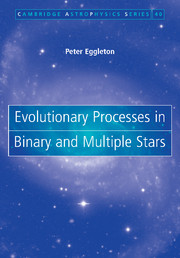Book contents
- Frontmatter
- Contents
- Preface
- 1 Introduction
- 2 Evolution of single stars
- 3 Binary interaction: conservative processes
- 4 Slow non-conservative processes
- 5 Rapid non-conservative processes
- 6 Accretion by the companion
- Appendix A The equations of stellar structure
- Appendix B Distortion and circulation in a non-spherical star
- Appendix C Perturbations to Keplerian orbits
- Appendix D Steady, axisymmetric magnetic winds
- Appendix E Stellar dynamos
- Appendix F Steady, axisymmetric, cool accretion discs
- References
- Subject index
- Stellar objects index
Preface
Published online by Cambridge University Press: 17 August 2009
- Frontmatter
- Contents
- Preface
- 1 Introduction
- 2 Evolution of single stars
- 3 Binary interaction: conservative processes
- 4 Slow non-conservative processes
- 5 Rapid non-conservative processes
- 6 Accretion by the companion
- Appendix A The equations of stellar structure
- Appendix B Distortion and circulation in a non-spherical star
- Appendix C Perturbations to Keplerian orbits
- Appendix D Steady, axisymmetric magnetic winds
- Appendix E Stellar dynamos
- Appendix F Steady, axisymmetric, cool accretion discs
- References
- Subject index
- Stellar objects index
Summary
This book is intended for those people, perhaps final-year undergraduates and research students, who are already familiar with the terminology of stellar astrophysics (spectral types, magnitudes, etc.) and would like to explore the fascinating world of binary stars. I hope it will also be useful to those whose main astrophysical interests are in planets, galaxies or cosmology, but who wish to inform themselves about some of the basic blocks on which much astronomical knowledge is built. I have endeavoured to put into one book a number of concepts and derivations that are to be found scattered widely in the literature; I have also included a chapter on the internal evolution of single stars.
In the interest of keeping this volume short, I have been brief, some might say cursory, in surveying the enormous literature on observed binary stars. It is almost a truism that theoretical ideas stand or fall by comparison with observation. My intention is to produce a second volume, with my colleagues Dr Ludmila Kiseleva-Eggleton and Dr Zhanwen Han, in which individual binary and triple stars that rate less than a line in this volume will be discussed in the paragraph or two each, at least, which they deserve. In addition, the synthesis of large theoretical populations of binary stars will be discussed. Some individual binaries can be seen as flying entirely in the face of the theoretical ideas outlined here – see OW Gem, Section 2.3.5.
Information
- Type
- Chapter
- Information
- Evolutionary Processes in Binary and Multiple Stars , pp. vii - viiiPublisher: Cambridge University PressPrint publication year: 2006
